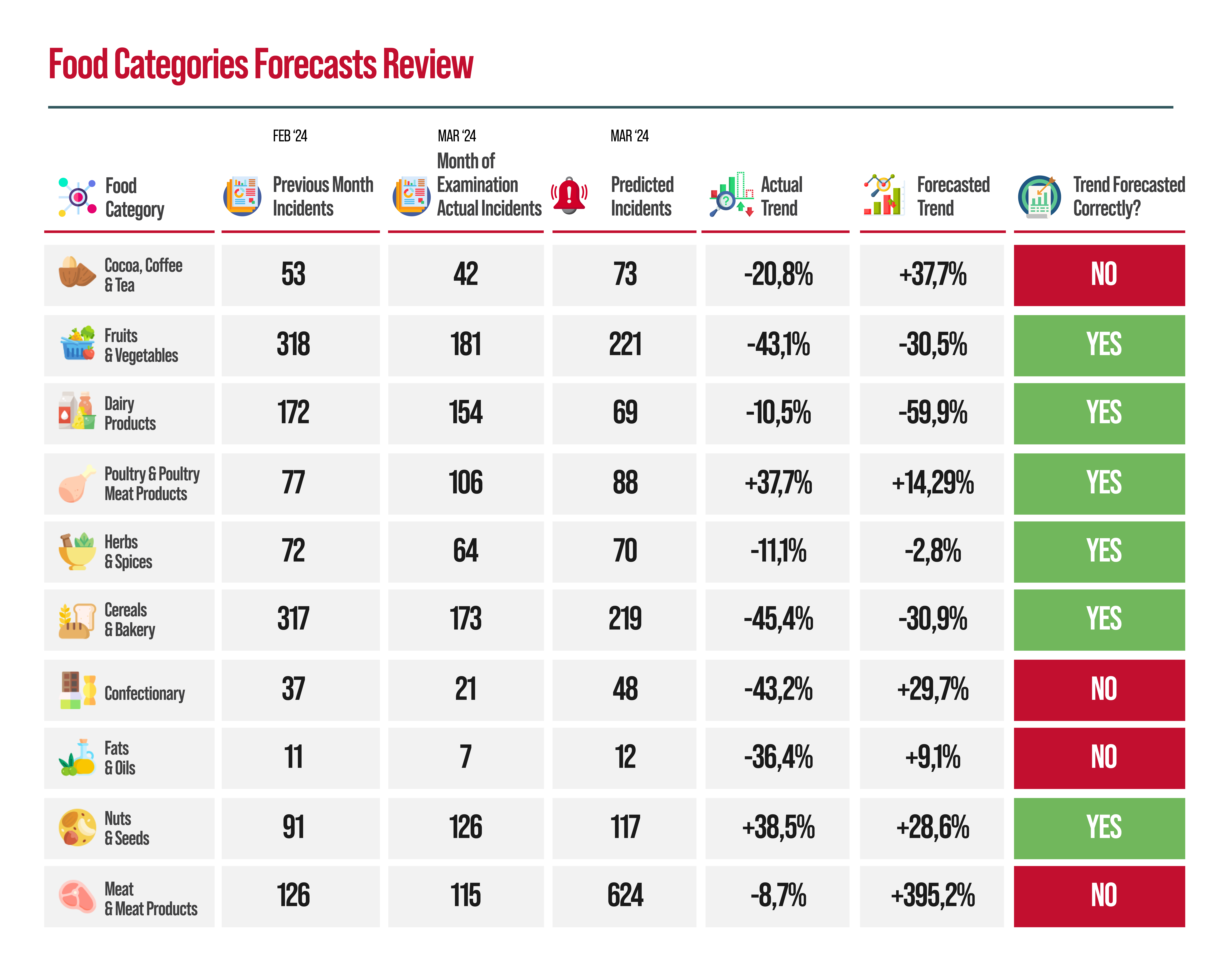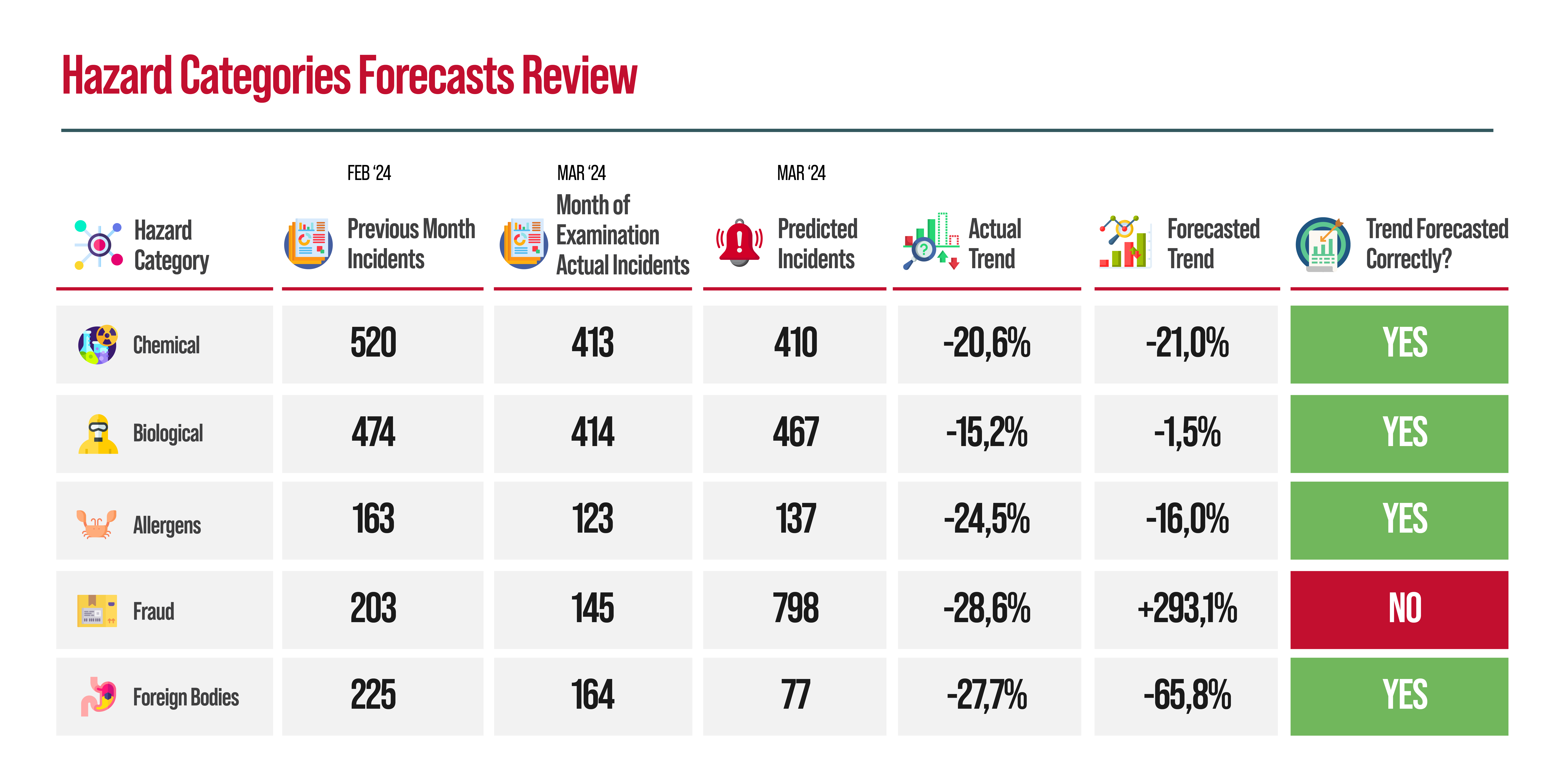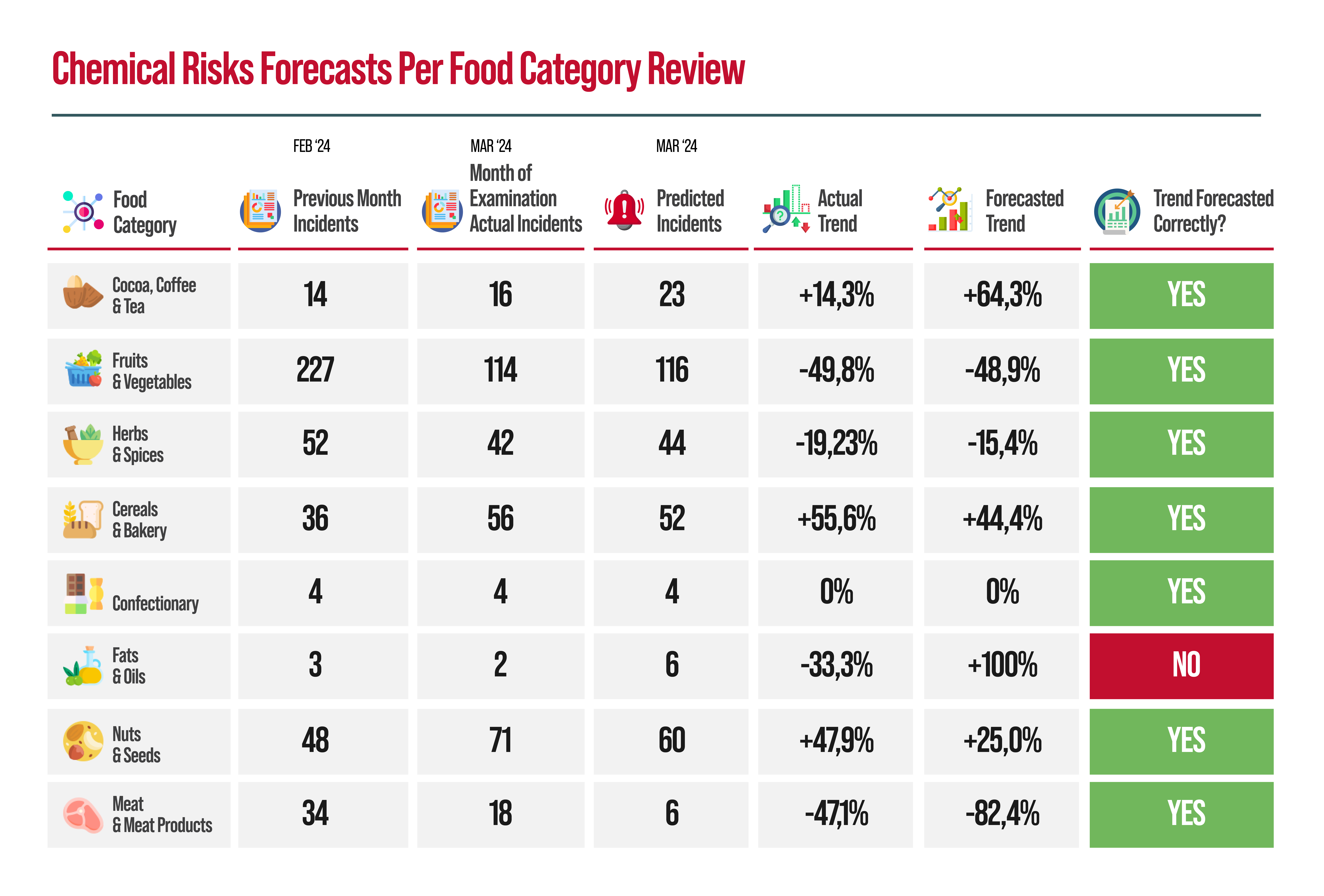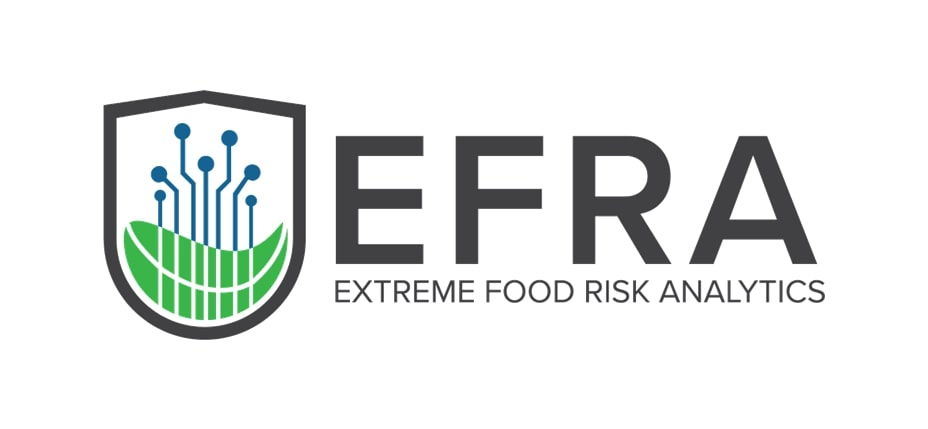
Monthly Forecasts Review: March
Welcome back to our Monthly Forecasts Review!
This article series where we review the performance of our incidents forecast’s trends for 10 key food categories for the previous month, March. In addition, we examine the performance of our hazards trend forecasts for the top Biological, Chemical, Foreign Bodies, Allergens Hazard Categories as well as Food Fraud. This time, we will shine a light on our Chemical Hazard Forecasts for an in-depth view.
How do we do that?
We compare the forecasted incidents trend for each food product category, hazard and risk category as highlighted by FOODAKAI, against the actual number of recorded incidents in each food product category, hazard and risk in the last month (March).
FOODAKAΙ is the AI-powered & predictive data analytics platform that collects, harmonizes and correlates data from approximately 200 public authority sources, which are then curated by food safety experts. Through continuously trained and updated AI models, FOODAKAI produces high-accuracy incident forecast trends for all known ingredients, raw materials and hazards.
For our previous edition, read here.
Key Food Categories Forecasts Review
As with our previous editions, we will be first looking at the overall incidents trend forecasts in 10 Key Food Categories for March.

As can be seen above the FOODAKAI platform correctly forecasted the incidents trend for 6 out of the 10 food categories, namely Fruits & Vegetables, Dairy Products, Poultry & Poultry Meat products, Herbs & Spices, Cereals & Bakery and Nuts & Seeds. However, the platform didn’t successfully forecast the number of incidents in the Cocoa, Coffee & Tea, Confectionary, Fats & Oils and Meat & Meat Products food categories.
Highlights:
- In the Cocoa, Coffee & Tea, FOODAKAI didn’t forecast the decreasing trend but rather forecasted an increase. This is mainly attributed to the model not detecting the decreasing trend for cocoa products.
- In the Fruits & Vegetables product category the platform forecasted with great accuracy the decreasing trend of incidents, anticipating a 30.5% decrease (221 incidents) compared to the 43.1% decrease (181 incidents).
- For Dairy Products, FOODAKAI managed to forecast the decreasing trend successful in the number of incidents (59.9%) in a difficult time series that included a number of peaks in incidents. While it forecasted the trend successfully, the platform predicted a higher percentage of increase than the actual (10.5%).
- In the Poultry & Poultry Meat products, while the platform forecasted the increasing trend successfully, the percentage of increase (14.29%) was lower than the actual trend (37.7%).
- For the Herbs & Spices product category, the decreasing forecasted trend was validated by the actual trend, although with a small difference in the level of decrease (2.8% forecasted vs 11.1% actual).
- In the Cereals & Bakery product category, the platform forecasted very accurately the decreasing trend with a 30.9% decrease (219 incidents) compared to the 45.4% decrease (173 incidents).
- For both of the Fats & Oils and Confectionary product categories, the platform didn’t forecast the decrease, but rather an increase in the number of incidents. This failure to forecast the decrease can be attributed to the difficulty in fitting a robust model for the category due to the lack of data and seasonality in the product categories.
- In the Nuts & Seeds product categories the platform anticipated with high accuracy the increasing trend of incidents, forecasting a 28.6% increase over the 38.5% actual increase.
- In the Meat & Meat products category, FOODAKAI didn’t detect the decreasing trend but an increasing. While a large difference between the percentages is evident, this, as mentioned, in our previous article is due to an ongoing open issue regarding one of the prime sources that delayed publishing the relevant incident reports for packaging defect incidents for the product category.
Hazard & Risk Categories Forecasts Review
Moving on from the overall incidents trends for the Top 10 categories, we will review the performance of the hazard & risk trend forecasts, meaning the forecasted incidents trend according to hazard and risk type compared to the actual number of incidents.

FOODAKAI successfully forecasted the incidents trend in 4 out of the 5 Hazard and Risk types: Chemical, Biological, Allergens & Foreign Bodies. It didn’t forecast the trend for Food Fraud incidents.
Highlights:
- For Chemical Hazards incidents, the platform managed a near-perfect forecasting of the number of incidents, predicting a 21.0% decrease (410 incidents) compared to the actual 20.6% decrease (413 incidents).
- For Biological Hazard incidents, the decreasing trend in the number of incidents was forecasted correctly, with a slight difference in the level of the actual decrease (15.2%) over the forecasted trend (1.5%).
- In the Allergen Hazard type category, FOODAKAI successfully forecasted the decreasing trend with 16.0% compared to the 24.5% actual trend.
- In the Foreign Bodies Hazard type category,while the AI-powered platform forecasted the decreasing trend, it predicted a higher-level decrease (65.8%) than the actual (27.1%) in the number of incidents attributed to the hazard.
- Regarding incidents attributed to Food Fraud, FOODAKAI, didn’t forecast the decreasing trend but rather an increase. As mentioned in our February article, this was due to the same issue reported above for Meat & Meat Products.
Chemical Hazards Forecasts Per Food Category
Finally, we will dive deeper into the forecasted vs the actual trends for incidents associated with chemical hazards for these 8 Food Categories. In the Dairy Products and Poultry & Poultry Meat Products category no incidents were recorded.

The platform correctly forecasted the chemical hazard incidents in 7 out of the 8 food categories: Cocoa, Coffee & Tea, Fruits & Vegetables, Herbs & Spices, Cereals & Bakery, Confectionary, Nuts & Seeds and Meat & Meat products. For the Fats & Oils Category the incident trend was not validated.
Highlight:
- Regarding Chemical Hazards in the Fruits & Vegetables and Herbs & Spices product categories, the platform forecasted with exceptional accuracy the decreasing trends over the months with only the slightest decrease in the percentages for both categories.
- For Chemical Hazards incidents in Cocoa, Coffee & Tea products, while the platform forecasted the increasing trend correctly, it did so with a difference in the level of increase from forecasted (64.3%) to actual trend (14.3%).
- In both Cereals & Bakery and Nuts & Seeds product categories, FOODAKAI forecasted the increasing trend in the number of incidents due to chemical hazards very accurately.
- For Confectionary products, FOODAKAI forecasted with complete accuracy that the number of incidents for this month with be the same with the previous month.
- In the Fats & Oils product category the platform didn’t manage to forecast the decrease but rather predicted an increase in chemical hazard incidents.
- Finally, for the Meat & Meat Products category, forecasted a higher level of increase (82.4%) compared to the actual (47.1&).
Through highly accurate incidents forecasts trend in for each product or ingredient food & beverage companies can consider emerging as well as new risks in the supply chain into their critical risk assessment processes. This way they can capitalize on proactive measures and formulate a robust risk mitigation strategy, safeguarding themselves against the always-increasing wave of new recalls and incidents.
Want to receive helpful food safety intelligence in your inbox?
 Funding for this research has been provided by the European Union’s Horizon Europe research and innovation programme EFRA (Grant Agreement Number 101093026). Funded by the European Union. Views and opinions expressed are however those of the author(s) only and do not necessarily reflect those of the European Union or European Commission-EU. Neither the European Union nor the granting authority can be held responsible for them.
Funding for this research has been provided by the European Union’s Horizon Europe research and innovation programme EFRA (Grant Agreement Number 101093026). Funded by the European Union. Views and opinions expressed are however those of the author(s) only and do not necessarily reflect those of the European Union or European Commission-EU. Neither the European Union nor the granting authority can be held responsible for them.








